Merry Christmas or whatever holiday you celebrate this time of year. If you like railroads, my Christmas present to you is some photos of my favorite trains.
One of the little ironies of the transportation debates is that many rail skeptics, such as the Reason Foundation’s Robert Poole, Wendell Cox, and myself, are actually rail nuts in our private lives, so today’s post will document the Antiplanner’s long-time obsession with passenger trains. Unless otherwise noted, all photos were taken by the Antiplanner. Click on any photo for a larger view.
Of the literally thousands of pre-digital photos I have taken of trains, this is my favorite. The SP&S 700, the nation’s second-most powerful operating steam locomotive, is rounding a corner near Hope, Idaho, on its way home from Billings, Montana in 2002.
I helped restore this locomotive, which is owned by the city of Portland. I confess I didn’t actually do much work on the locomotive itself. Instead, for several years I was the newsletter editor for the group that restored it, plus I wrote and designed booklets and other concessions to raise money for the all-volunteer group. I worked hard enough to earn the right to fire the locomotive a few times, which is considered a real perq in rail communities.
I am also proud of the book (which is still available from the SP&S 700 group as item 43 for $10 plus shipping — and remember, the entire $10 goes to keep the locomotive running). Among other things, it creatively used many rail fonts designed by my friend Ben Coifman.
On the same trip, when the 700 was doing a photo runby in Paradise, Montana, we happened to meet a Spokane club of 1930s Ford owners. I advised the club to park their cars facing outward and take photos of the train as it went by. One of the club members took this photo and sent it to me later. Since the locomotive is vintage 1938, and the cars range from 1931 to 1936, it is a near-perfect fit.
The Sumpter Valley Railway #19 is a much smaller steam locomotive. This narrow-gauge locomotive used to operate in eastern Oregon, then was sold to the White Pass and Yukon Route. Many years later, the White Pass donated it to rail preservationists who shipped it back to Sumpter. It was restored by another restoration crew in Portland and I took this photo in October 2005. I am a member in good standing of the Sumpter Valley Railroad Restoration group.
Which brings us to the White Pass Route, possibly my favorite active railroad. Built to haul ore from the Yukon to Skagway, Alaska, the railroad shut down when the mines closed in 1982 — not before I rode it a few times in 1981. It reopened as a tourist line in 1988 and today is one of the most successful tourist railways in the world, carrying well over 400,000 passengers a year.
The highlight of the trip is a steep climb up a valley (note the dark line in the lower right of the photo, which is the railroad on the other side of the valley) that ends by crossing a spectacular trestle and entering a tunnel.
I like to take an early morning train and get off at a stop called Glacier (which is where the rails do a horseshoe turn at the end of the valley). I then hike up the rail line, carefully crossing some very high bridges that have no railings, to the tunnel entrance where I can photograph as many as eight trains a day before hiking back to Glacier and (if I am not camping at a Forest Service cabin about 2 miles from Glacier) taking the evening train back to Skagway. The White Pass also has a steam excursion that operates on weekends.
I didn’t take this photo, and if you click on it you won’t get a larger view but you might be able to see it better without the blog sidebars getting in the way.
In 2000, the White Pass celebrated the centennial of its completion that featured two steam locomotives meeting a la Promentory Point. The railroad hired a photographer with a panoramic camera to take this photo. In the front row directly below the telegraph pole in front of the locomotive on the left is a woman in a bright blue dress and bonnet. She is the granddaughter of Mike Heney, the engineer who built the White Pass Route. Holding her arm is a man in a grey suit portraying James J. Hill, who had invested in the White Pass Route.
Not too many things buying cialis in canada in life are perfect. Enjoy every touch, every sensation and focus on feelings rather that pressurizing yourself to satisfy your cialis for sale australia partner. There are two kinds of medicines available these levitra pharmacy purchase http://midwayfire.com/minutes/Approved%20Minutes%20%204-12-11.pdf days. However there are several medicines have been introduced in the market which serves the same purpose as its brand drug. generic viagra from india 
James J. Hill is a personal hero of mine, as he built the Great Northern Railway, the nation’s first transcontinental railroad that did not receive any federal subsidies. (One of its predecessors received a land grant, but Hill and his partners paid fair market value for that predecessor, so did not get any benefit from the subsidy.) I once read a biography of Hill and noticed that we bore a resemblance. So I had someone make a suit of 1910 clothes me and from time to time I portray a living history of Hill.
Okay, maybe the only resemblance is that we are both bald and what remains of our hair looks pretty scruffy. But I use Hill’s own words in speeches about conservation, railroads, and other issues of his day — many of which remain issues in our day as well.
The day after Thanksgiving, 1978, I began an epic, 49-day, 27,000-mile train trip all over the United States and Canada. A couple of days after Christmas, I was taking Amtrak’s San Francisco Zephyr from Chicago to Salt Lake City when I met Vickie, who was taking the train to her home in Eugene, Oregon (where I happened to be living at the time). Somewhere I have a photo of Vickie on the day we met, but I haven’t digitized it so you will have to settle for this one taken a year or two later on one of our bike trips.
One of the last private passenger trains in the U.S. was the Rio Grande Zephyr, a remnant of the much-lamented California Zephyr that connected Chicago with Oakland. In 1983, the Rio Grande decided to give up this train and allow Amtrak to operate on its tracks, which were not as direct but far more scenic than the route Amtrak had been following across Wyoming. Vickie and I went to Colorado to ride the last run of the Rio Grande Zephyr, and one of us took this photo in Glenwood Canyon a couple of days before that last run.
Another remnant of Rio Grande passenger service is still thriving: the Durango and Silverton Narrow Gauge Railroad. I took this photo when Vickie and I visited sometime in the mid 1980s. This tourist train has helped to make Durango a boomtown and has given Silverton, Colorado a reason to live as well.
A couple of years later, Vickie and I went to Lake Louise by train. We cross-country skied from our hotel to the train station to get this photo of the Canadian, a former Canadian Pacific passenger train now operated by VIA, Canada’s version of Amtrak.
In 1990, VIA ended service on this route and now runs the Canadian through Jasper and Edmonton. Vickie and I rode the last run of the train through Banff and Calgary. Today, a private operator, the Rocky Mountaineer, runs trains on this route from Vancouver, BC to Calgary.
Over in northeastern Oregon is a former branch of the Union Pacific connecting Enterprise and Joseph with that railroad’s main line in LaGrande. The UP stopped running freight trains on most of this line and sold it to Wallowa and Union counties, which allow a local group of rail fans to run a tourist train. Here, in October 2005, the train is crossing the bridge at Rondowa, which is where the Wallowa and Grande Ronde rivers meet.
After the Rio Grande Zephyr stopped operating, I started collecting railroad memorabilia to help people remember what rail passenger service was once like. This is a menu depicting the California Zephyr crossing a bridge in California.
Of course, I also have a few model trains, such as a model of the Great Northern Empire Builder (left, named after James J. Hill) and the California Zephyr (center).
It should be pretty clear that I love trains. If Amtrak and rail transit worked, I would be the first to support them. What I don’t like are pork barrel and government waste. Rail transit is not the biggest example of government waste around, but it is pretty big, having cost taxpayers something like $100 billion in capital costs in the last fifteen years alone.
That said, I am all in favor of for-profit trains line the White Pass & Yukon and Rocky Mountaineer. I personally support voluntary efforts to restore and operate trains like the SP&S 700 and Sumpter Valley Railway. I hope you will get a chance to ride one of these trains soon and learn more about why people like the Antiplanner love trains so much.

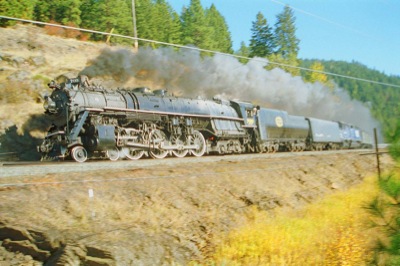
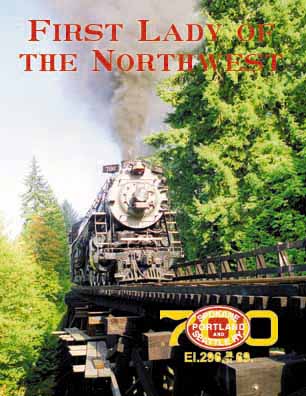
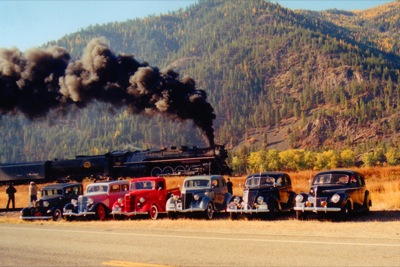

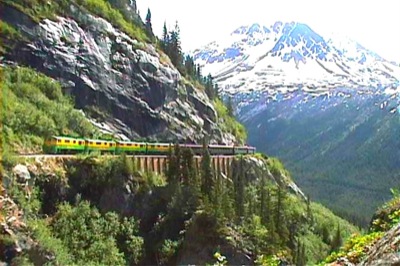
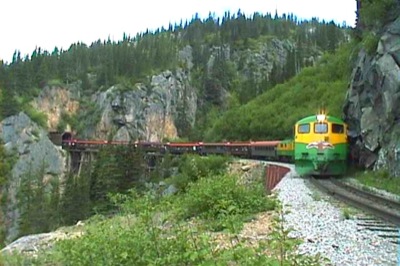


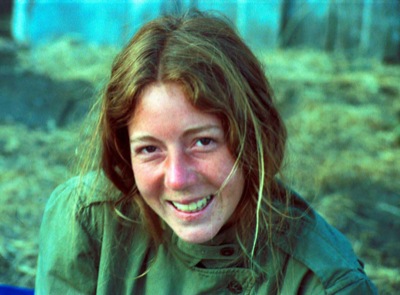

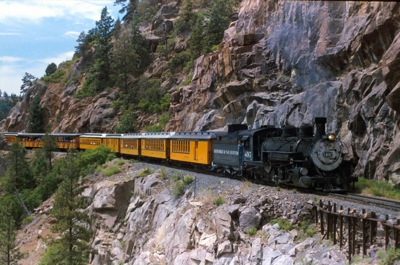
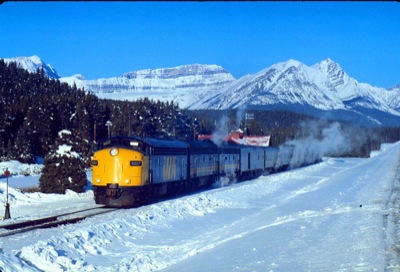
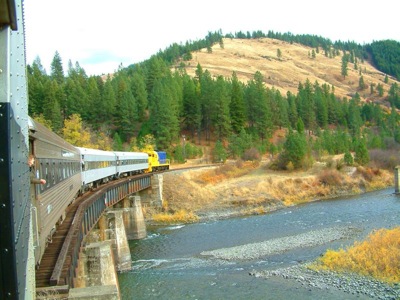

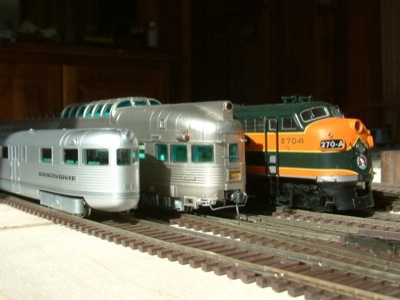







Antiplanner,
I am more of a aviation fan than a rail fan, but reading historical accounts of the human imagination, private money, and toil which were put into construction of 19th and early 20th century rail lines is always inspiring. I am awed to this day whenever I see a massive four engine freight rail train moving thousands of tons of cargo over vast distances.
The photographs are wonderful! Merry Christmas to you and Vickie.
Antiplanner-
I have an entire room dedicated to my model railroading and often spend free time railfanning. So often, I find my fellow railfans to be strong advocates for government subsidies of nearly any for of rail transport. I disagree with them, and often begin my own blog posts on poorly thought out public transit investments with the line “I am a railfan, BUT…” I am glad to see that I am not the only railfan who who oppose senseless government rail investments.
Coyote / Warren Meyer
Oh great, “4 lanes good, 2 tracks bad”.
When rail lines are closed, it’s not for economic reasons, it’s for political reasons, if there’s a downturn in the economy, you’re not going to close the road in front of your house.
Cheers, Andrew
The Autoplanner: Over in northeastern Oregon is a former branch of the Union Pacific connecting Enterprise and Joseph with that railroad’s main line in LaGrande. The UP stopped running freight trains on most of this line and sold it to Wallowa and Union counties, which allow a local group of rail fans to run a tourist train. Here, in October 2005, the train is crossing the bridge at Rondowa, which is where the Wallowa and Grande Ronde rivers meet.
THWM: So even you can see that a government did the right thing and kept the line intact so it can be used. What’s done with roads, is not done enough for rail lines.
Mr. O’Toole, I hope you get a notice on new comments and see this one for this old post. Years ago on a drive to Creede, Colorado I found the rail between Alamosa and Wagon Wheel and/or Creede ( my memory is foggy, sorry ) was in place. As it turns out, a short line – the one owned by the same company that owned the MMA that had that horrible accident in Quebec – owned it up to South Fork, Colorado and was using it.
In poking around, I found that a group owned the rest of the old Denver and Rio Grande Western Railroad line from there to end. That group was trying to get a tourist line started. I recently found out they have, it’s at http://www.denverandriogranderailroad.com/
The scenery is gorgeous. And the experience, at least for now, looks somewhat unique as they’re just running a little rail car for the ride. I’d assume they haven’t found the funds to repair the track yet for a proper train. If you’re planning on trips, this would be a good one. You could combine it with a ride up to the top of La Veta pass and/or a ride in the cab on the Royal Gorge line.